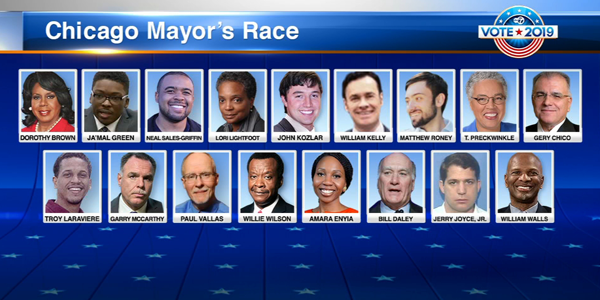
Chicago’s Clues for the 2020 Democrats
Written by Michael Barone
There was a record-sized field of candidates containing as many women as men. Their surnames ranged from the long familiar to the novel and exotic; they had multiple racial and ethnic backgrounds, and at least one gay candidate was in the running. This sounds like the ever-expanding list of candidates for the 2020 Democratic presidential nomination, but it’s also a description of the field in last month’s primary election for mayor of Chicago.
It was a new experience for Chicago, two-thirds of whose elections over the last 65 years have produced mayors named Richard Daley. The 1980s saw high-turnout contests between black candidates and whites based in the “bungalow wards.” Retiring Mayor Rahm Emanuel‘s base was high-education whites the in Lakefront wards, in combination with Hispanics against a black runoff opponent, and blacks against a Hispanic.
This year’s multicandidate contest, so different from the past, provides several clues as to how the Democrats’ multicandidate presidential contest might unfold.
First, it could turn out to be a tie. In Chicago, six of the top nine candidates received between 5 and 11 percent, and the top three got 17, 16 and 14 percent. There will be an April 2 runoff between the top two finishers, Police Accountability Task Force member Lori Lightfoot and Cook County Board of Commissioners President Toni Preckwinkle, with a clear winner.
But if votes are sprinkled as evenly among the Democratic presidential candidates, there won’t be an automatic tiebreaker. Democrats’ delegate allocation rules favor proportionate representation, so no one may go into the July 2020 national convention with a majority. Under new party rules, the superdelegates — party leaders and officeholders — can chime in on a second ballot. Nothing like this has happened since 1952, three years before the election of the first Mayor Daley.
The second interesting thing here is the changing composition of the nearly all-Democratic Chicago electorate. In the 1980s, the key groups, South Side and West Side blacks, and bungalow ward whites, comprised perhaps 80 percent of the electorate. This year, the 19 predominantly black wards cast just 35 percent of the votes, and the six bungalow wards, after years of ethnic white outmigration, just 16 percent.
The city’s expanding number of white college graduate gentrifiers has expanded the Lakefront zone far inland. It cast 32 percent of the vote, giving Lightfoot, with her lack of political machine roots and lesbian identification, 27 percent of its votes. If the runoff goes as expected, the Lakefront will have made her mayor.
This reflects the increasing heft of white college graduates in Democratic politics. Upscale whites, not minorities, produced the upset by U.S. Represenative Alexandria Occasion-Cortez in her Queens-Bronx primary last June, and upscale whites in suburbs were key to Democrats’ takeover of the U.S. House last November.
But the upscale white dominance didn’t produce upscale white winners in Chicago. Both runoff contenders are women. And women received 53 percent of the vote citywide, and 60 percent in the Lakefront wards. That’s a favorable omen for women presidential candidates that suggests they could overtake current frontrunners Joe Biden and Bernie Sanders.
And both the winners are black, despite sizable black outmigration from Chicago to the suburbs and the South. The Chicago primary did have candidates with 1980s-style monoracial appeal — Jerry Joyce got 21 percent in the bungalow wards but only 4 percent in non-white areas; South Side-based Dr. Willie Wilson got 25 percent in black wards but only 3 percent in nonblack wards.
But Lightfoot, Preckwinkle and former top Bill Clinton and Barack Obama aide Bill Daley got double-digit percentages in white, black and Hispanic areas. Voters seem to have valued past records, attitudes on key issues and personal character more than simple ethnicity.
Daley just failed to make the runoff, but the relative strength of this near septuagenarian (born 1949) could be good news for Biden (born 1942) and Sanders (born 1941). It suggests that the twists and turns inevitable in successful careers over long periods of time — Daley’s father was first elected mayor in 1955, his brother in 1989 — can be assets as well as liabilities.
A final implication of the Chicago primary is turnout. Whites and blacks make up about 40 percent of the city’s voting population, Hispanics about 20 percent. But this year, predominantly white wards cast 48 percent of primary votes, black wards 35 percent, Hispanic wards 17 percent.
Flagging black enthusiasm about voting in the post-Obama era hurt Hillary Clinton in the 2016 primaries, and especially in November. Chicago’s results show that even as the city elects a black mayor, black turnout may disappoint the Democratic nominee again.
Michael Barone is a senior political analyst for the Washington Examiner, resident fellow at the American Enterprise Institute and longtime co-author of The Almanac of American Politics.












